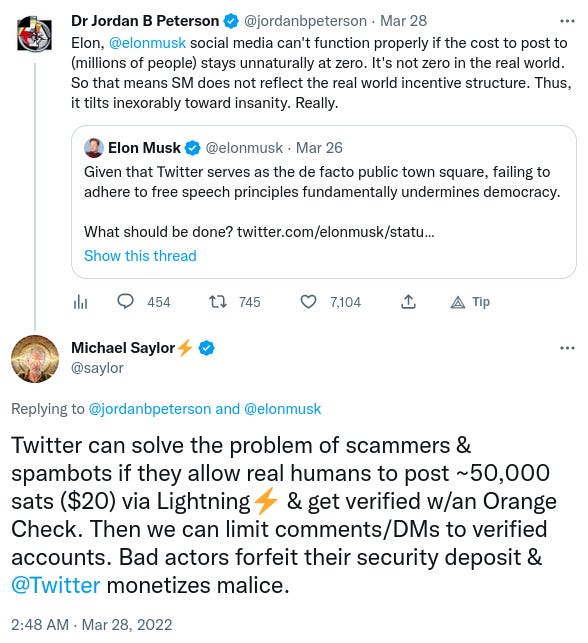Fighting Spam with Bitcoin
Spam has become so ubiquitous that we’ve already gotten used to it as a part of the Internet landscape. It doesn’t have to be that way, because we have the technology that can clean up the information noise online.
Unwanted and irrelevant messages online consume our attention – a limited and precious resource. Spam and scam often go hand in hand. By eradicating spam we can also remove a point of access for many scammers, who think they can get more than our attention for free.
Bitcoin is the signal
Inventions regarding fighting spam online are interconnected with the evolution of blockchain technology, and we can track them back to the early days of the Internet. In the 1990s, we had two parallel inventions, that still have untapped potential in the battle against online spam.
Inevitable micropayments
David Chaum is mostly known for creating the first electronic cash system, called eCash. He’s also recognized for laying foundations for privacy-protecting technologies online with his 1981 paper titled “Untraceable Electronic Mail, Return Addresses, and Digital Pseudonyms”. In 1994, Chaum foresaw micropayments as an inevitable element of the digital world for The New York Times:
“As payments on the network mature, you’re going to be paying for all kinds of small things, more payments than one makes today. (…) Every article you read, every question you have, you’re going to have to pay for it.”
— David Chaum
Combating junk mail
By the early 1990s, the usefulness of the Internet became obvious. Electronic mail was growing in popularity, and so did spam. IBM researchers Cynthia Dwork and Moni Naor in their 1992 paper titled “Pricing via Processing or Combatting Junk Mail” presented a solution to attach a small amount of additional data to each email sent. This data would be a solution to a computational problem, based on public-key cryptography and signature schemes. The computational overhead would be unnoticeable for a single email sent, but for a spammer, who wants to send bulk emails the computation time would increase proportionally to the number of emails to be sent. Spamming could be made expensive, and thus unprofitable.
“In particular, the easy and low cost of sending electronic mail, and in particular the simplicity of sending the same message to many parties, all but invite abuse.” — Cynthia Dwork and Moni Naor
Later, this type of solution became known as proof of work.
Hash-based postage scheme
Around the same time as Dwork and Naor, British cryptographer Adam Back came up with a parallel invention. Back focused his postdoctoral efforts on fighting spam online. Analyzing possible solutions, he shared one of his ideas with The Cypherpunks mailing list in the mid-1990s:
“A side benefit of using PGP, is that PGP encryption should add some overhead to the spammer — he can probably encrypt less messages per second than he can spam down a T3 link.” — Adam Back
In 1997, a 26-year-old Back submitted his proposal to The Cypherpunks mailing list. In his message Back described a stamp equivalent for emails called a “partial hash collision-based postage scheme”, which he also referred to as Hashsash. Unlike Dwork and Naor’s solution, his proposal wasn't based on cryptographic puzzles but was based on hashing, which takes any data and converts it into a hexadecimal number of predetermined length.
“The idea of using partial hashes is that they can be made arbitrarily expensive to compute, and yet can be verified instantly.” — Adam Back
Although the idea didn’t take off initially in a big way, it still has the potential to eliminate online spam. This could be achieved by making a single message very cheap to send, so that the cost will be almost unnoticeable for an average user, but very expensive for spammers when they want to send thousands or millions of emails at once.
Social media
To remove the noise created by junk content on social networks, a proof of stack mechanism could also be used. Such a stake is required to publish and interact with other people’s content. For every interaction on the platform, a small amount of satoshi is necessary to be put on the stack. Bitcoin is way more divisible than fiat money, and thus we can divide and efficiently operate with Internet money in fractions of a penny.
The staked amount could be returned after a short time; long enough for a community to validate if the message was in line with platform policy. If published content violated the policy, then the staked amount is lost as a penalty for breaking the rules.
This particular way of staking is used by Sphinx Chat, and this is how the app founder – Paul Itoi – describes their approach to returnable micropayments:
“Adding the ability to require a micropayment with each message prevents spam. The payment is too small for the sender to notice, but it’s enough to make spam unprofitable at scale. These tiny payments are the immune cells that push out the junk content that plagues Reddit, Discord, and Twitter.” — Paul Itoi
The platform policy validation process could be done by the community, administrator, or entirely via smart contracts with clearly defined and publicly visible rules to automatically guard the policy and keep spammers away.
There was a debate on Twitter before Elon Musk even announced he wanted to buy the platform. His push in the direction of verified accounts with $8 blue checks may be closely related to fighting spam:
Spam can be eliminated by a proof of stake as Michael Saylor suggests, or by a proof of work, invented by Adam Back in the early days of the Internet. It may also be a combination of both.
Fix the Money, fix the world
The problem with spam is that its small cost can be rounded down to zero, but sending bulk messages online is not free – it requires real-world resources, and the price we pay is attention. Before the Internet, our ancestors already figured out that attention has value. It’s even embedded in our language so that we pay (with) attention. The fix that Bitcoin brings to Money also carries a solution to clean up our mailboxes and social media platforms. The good news is that the technologies underpinning Bitcoin are rooted in attempts to eliminate spam, so the battle against online junk is not yet lost.
Bibliography
"The Genesis Files: How David Chaum's eCash Spawned a Cypherpunk Dream" by Aaron van Vidrum, The Bitcoin Magazine, April 24, 2018
"The Genesis Files: Hashcash or How Adam Back Designed Bitcoin's Motor Block" by Aaron van Vidrum, The Bitcoin Magazine, June 4, 2018
“Defeating Spam Bots Using Bitcoin”, The Blog of Zion, May 14, 2022
Thanks for reading!
To support the Bitcoin Masterclass newsletter you can stack some sats in my Bitcoin Lightning wallet:
lnurl1dp68gurn8ghj7ampd3kx2ar0veekzar0wd5xjtnrdakj7tnhv4kxctttdehhwm30d3h82unvwqhhxurfddukyctjxq6s4xrxlh





